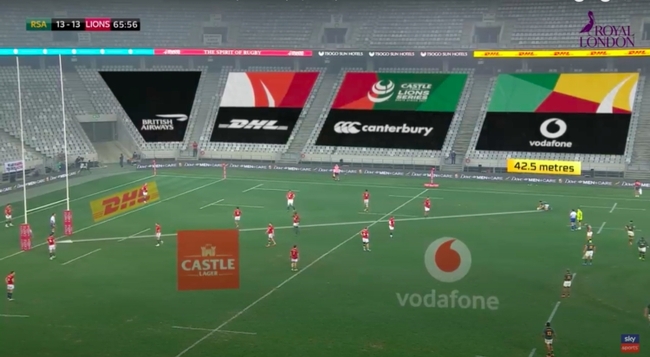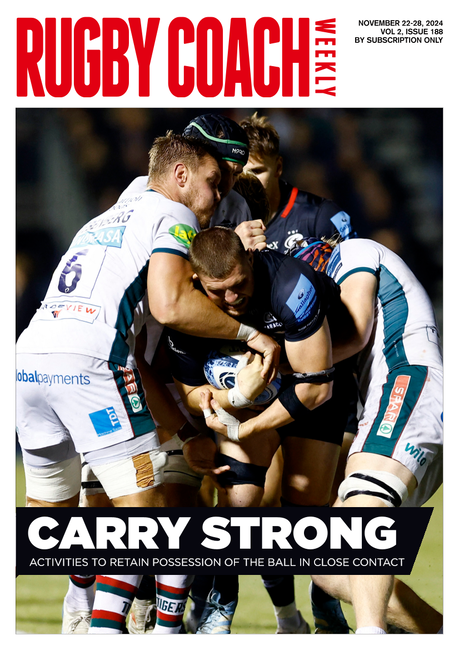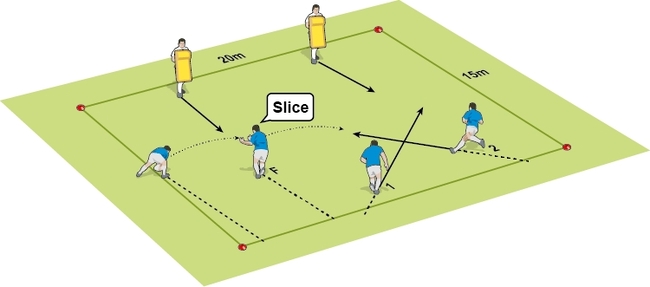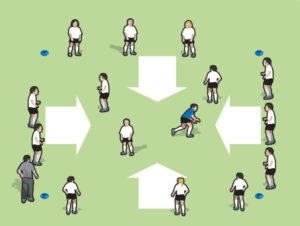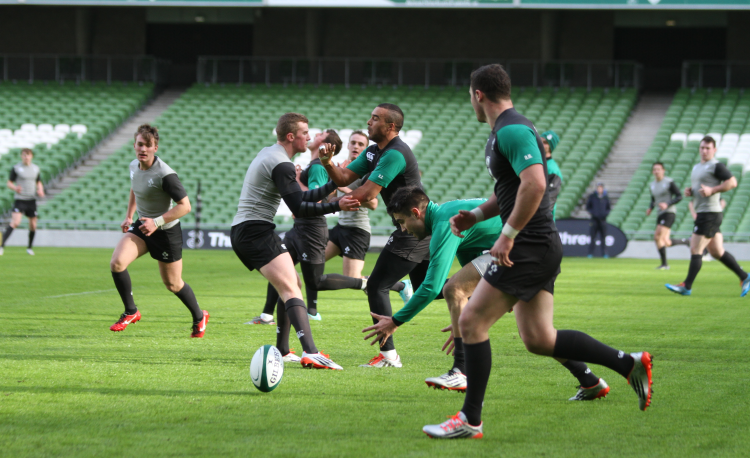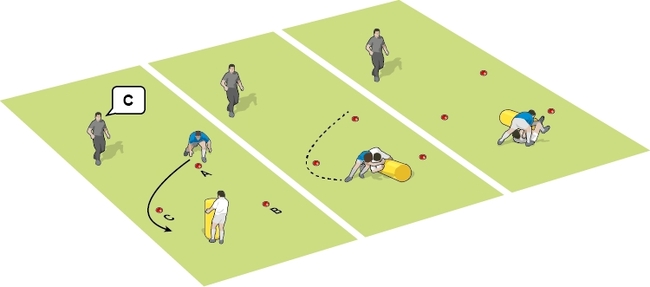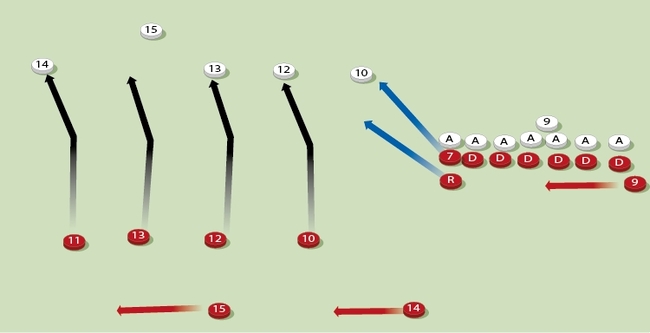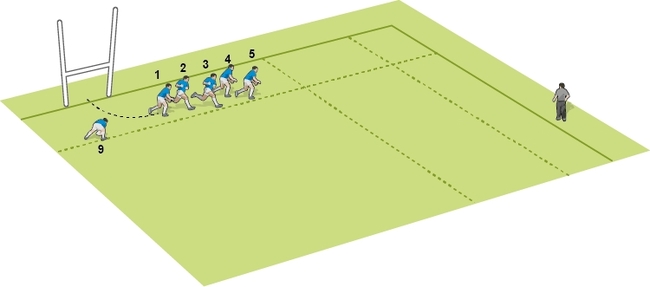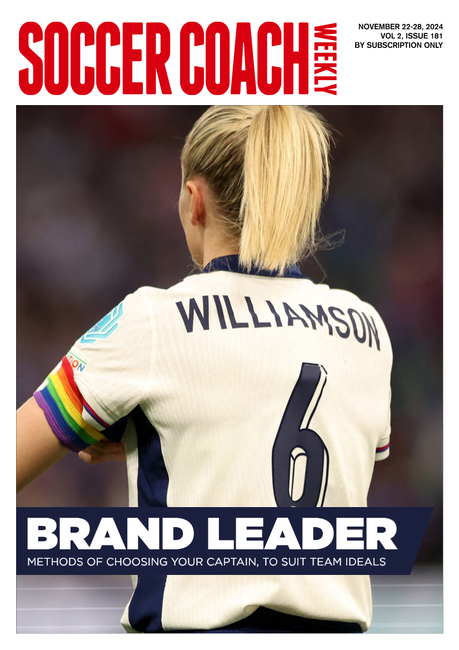Use scenarios to engage players
Small-Sided Gamesby Tom Brocklebank
Tom Brocklebank, DPP coach at Leicester Tigers introduces his scenario cards.
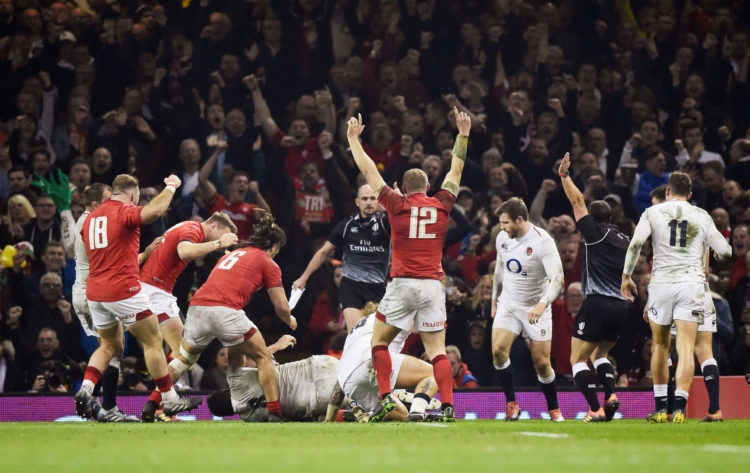
Scenarios offer a great way of engaging your players in games. By putting the players in a specific point of a well known match, they get the opportunity to develop their game management. For younger players, scenarios give them the opportunity to be their favourite players of their favourite teams. For older players, scenarios give them the opportunity to challenge their decision making with regards to the score-line and also how to deal with specific threats or weaknesses in future opposition.
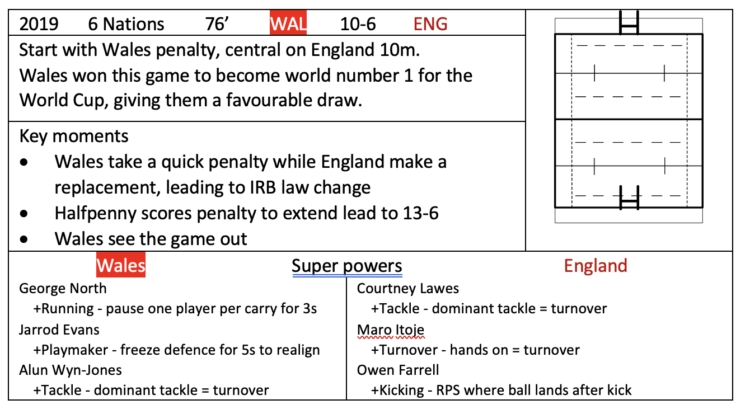
Scenarios are a very open-ended method, with a number of possibilities, so I encourage you to try different things out and don’t just limit yourself to how I use them, which will be what I’m going through below and in future scenario articles.
I use scenarios for the game towards the end of a training session. The scenario will be linked to the outcomes of the previous activities to offer the players the opportunity to apply what they have learnt in a realistic game situation.
I aim to link outcomes to the World Rugby principles of play, however feel free to align them to your own team’s principles or whatever you and your team feel you need to focus on. In the scenario, both teams become the teams from the scenario, you can look at specific players as well, starting the game at the exact same moment as the scenario, whether that be a penalty or a scrum or open play.
Both teams are aware of the score, and will play out the rest of the scenario to determine a winner, giving them the opportunity to ‘change history’.
First find a match that will engage your players. This could be a British and Irish Lions match, a Premiership match, or even a local match of your first team.
Next, you need to find a moment in the match to begin the scenario. Starting the scenario with the scores equal will allow the game to play out like a normal game, whereas choosing a moment where one team is winning will encourage either team to create a strategy according to the score. A losing team may be more willing to take risks, a winning team may be more willing to play safe. These experiences will help your players when they are winning or losing in their own games.
If you’ve never used scenarios with your players, I would stop here and simply use the score-line and the teams.
Once your players are used to scenarios you can start to introduce more, such as team rules or player rules. You need to link the rules to your aims for your players. Again, I like to link these to the World Rugby principles of play.
Team rules will encourage each team to play a certain way, this can be used to prepare your players for a match at the weekend or can fit into your long term planning to improve certain skills or principles of play. A team rule is applied to the whole team, including each individual player. I like to link this to the teams in the scenarios.
Some quick examples of national teams, a principle of play they are good at, and a team rule to encourage them include:
Springboks – ‘go forward’ Award a turnover if a Springbok makes a ‘dominant’ tackle (moves the ball carrier back towards their try line)
All Blacks/Black Ferns – ‘continuity’ A player who receives the ball from an offload can’t be touched for 3 seconds
Argentina – ‘contest possession’ Award a turnover if an Argentinian player can get their hands on the ball at a ruck
England – ‘apply pressure’ Award a lineout to England when they kick the ball to touch from open play
Again, you can apply this to your local teams, for example, if you are playing a team at the weekend who are a physically dominant team who focus on their ‘go forward’, apply team rules that encourage your team to replicate this.
I use them in relation to our long term planning: if we are in a block of training sessions that focus on ‘go forward’, I may pick a scenario that encourages both teams to go forward in different ways, or even in the same way; this is better for age grade players where there will hopefully be less of a focus on short term gains for the next match and more of a focus on long term player development of their skills and principles of play.
These rules apply to individual players. It can be hard to keep track of these as a ref, so I recommend only using this when your players are comfortable with scenarios and using team rules. You are therefore able to apply extra awareness to specific player rules.
You can also make these players wear different bibs, or wear a headband, or have no distinguishing features to add an extra challenge. These rules can be in addition to or instead of team rules depending on your players' abilities and awareness.
Some quick examples include:
Again, use these as part of your long term planning, or you can use them to prepare for specific players you know you’re up against at the weekend. For example, if there’s a player who loves to take the ball into contact and not look for a pass (like Basteraud or Lomu) you can apply a player rule that if that player is tackled by two players at the same time, they are awarded a turnover.
Scenario example

Scenarios offer a great way of engaging your players in games. By putting the players in a specific point of a well known match, they get the opportunity to develop their game management. For younger players, scenarios give them the opportunity to be their favourite players of their favourite teams. For older players, scenarios give them the opportunity to challenge their decision making with regards to the score-line and also how to deal with specific threats or weaknesses in future opposition.

Scenarios are a very open-ended method, with a number of possibilities, so I encourage you to try different things out and don’t just limit yourself to how I use them, which will be what I’m going through below and in future scenario articles.
I use scenarios for the game towards the end of a training session. The scenario will be linked to the outcomes of the previous activities to offer the players the opportunity to apply what they have learnt in a realistic game situation.
I aim to link outcomes to the World Rugby principles of play, however feel free to align them to your own team’s principles or whatever you and your team feel you need to focus on. In the scenario, both teams become the teams from the scenario, you can look at specific players as well, starting the game at the exact same moment as the scenario, whether that be a penalty or a scrum or open play.
Both teams are aware of the score, and will play out the rest of the scenario to determine a winner, giving them the opportunity to ‘change history’.
CREATING A SCENARIO
First find a match that will engage your players. This could be a British and Irish Lions match, a Premiership match, or even a local match of your first team.
Next, you need to find a moment in the match to begin the scenario. Starting the scenario with the scores equal will allow the game to play out like a normal game, whereas choosing a moment where one team is winning will encourage either team to create a strategy according to the score. A losing team may be more willing to take risks, a winning team may be more willing to play safe. These experiences will help your players when they are winning or losing in their own games.
If you’ve never used scenarios with your players, I would stop here and simply use the score-line and the teams.
OPTIONS
Once your players are used to scenarios you can start to introduce more, such as team rules or player rules. You need to link the rules to your aims for your players. Again, I like to link these to the World Rugby principles of play.
TEAM RULES
Team rules will encourage each team to play a certain way, this can be used to prepare your players for a match at the weekend or can fit into your long term planning to improve certain skills or principles of play. A team rule is applied to the whole team, including each individual player. I like to link this to the teams in the scenarios.
Some quick examples of national teams, a principle of play they are good at, and a team rule to encourage them include:
Springboks – ‘go forward’ Award a turnover if a Springbok makes a ‘dominant’ tackle (moves the ball carrier back towards their try line)
All Blacks/Black Ferns – ‘continuity’ A player who receives the ball from an offload can’t be touched for 3 seconds
Argentina – ‘contest possession’ Award a turnover if an Argentinian player can get their hands on the ball at a ruck
England – ‘apply pressure’ Award a lineout to England when they kick the ball to touch from open play
Again, you can apply this to your local teams, for example, if you are playing a team at the weekend who are a physically dominant team who focus on their ‘go forward’, apply team rules that encourage your team to replicate this.
I use them in relation to our long term planning: if we are in a block of training sessions that focus on ‘go forward’, I may pick a scenario that encourages both teams to go forward in different ways, or even in the same way; this is better for age grade players where there will hopefully be less of a focus on short term gains for the next match and more of a focus on long term player development of their skills and principles of play.
PLAYER RULES
These rules apply to individual players. It can be hard to keep track of these as a ref, so I recommend only using this when your players are comfortable with scenarios and using team rules. You are therefore able to apply extra awareness to specific player rules.
You can also make these players wear different bibs, or wear a headband, or have no distinguishing features to add an extra challenge. These rules can be in addition to or instead of team rules depending on your players' abilities and awareness.
Some quick examples include:
- Handre Pollard (Springboks) – award a free kick where a kick out of hand lands
- Portia Woodman (Black Ferns) – can freeze one player per carry, must call it and call with enough time for the opposition to react
- George Ford (England) – can freeze opposition for 3 seconds to allow time to realign
- Vicky Fleetwood (England) – turnover if they get their hands on the ball at a ruck
Again, use these as part of your long term planning, or you can use them to prepare for specific players you know you’re up against at the weekend. For example, if there’s a player who loves to take the ball into contact and not look for a pass (like Basteraud or Lomu) you can apply a player rule that if that player is tackled by two players at the same time, they are awarded a turnover.
Scenario example
Related Files
Vol-2-Issue-022-T-Brocklebank-use-scenarios-to-engage-players.pdfPDF, 538 KB
Newsletter Sign Up
Coaches Testimonials

Gerald Kearney, Downtown Las Vegas Soccer Club

Paul Butler, Florida, USA

Rick Shields, Springboro, USA

Tony Green, Pierrefonds Titans, Quebec, Canada
Subscribe Today
Be a more effective, more successful rugby coach
In a recent survey 89% of subscribers said Rugby Coach Weekly makes them more confident, 91% said Rugby Coach Weekly makes them a more effective coach and 93% said Rugby Coach Weekly makes them more inspired.
Get Weekly Inspiration
All the latest techniques and approaches
Rugby Coach Weekly offers proven and easy to use rugby drills, coaching sessions, practice plans, small-sided games, warm-ups, training tips and advice.
We've been at the cutting edge of rugby coaching since we launched in 2005, creating resources for the grassroots youth coach, following best practice from around the world and insights from the professional game.
